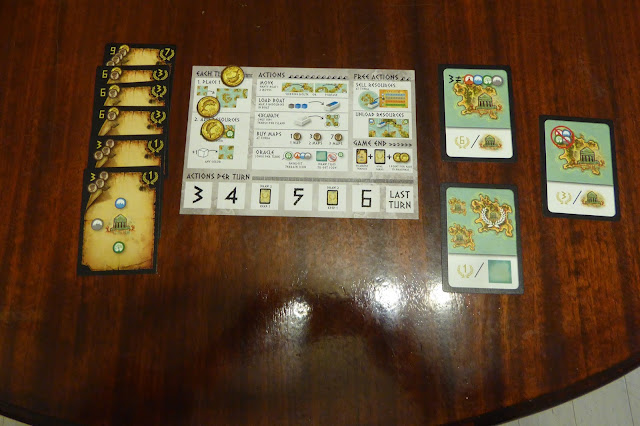Hi folks,
Akrotiri is a fantastic little game for two players that combines some of the best game mechanics from my favourite games.
My wife and I came across Akrotiri quite randomly, when we were trolling through a boardgame website looking for something new. It looked to have a lot of elements from Carcassonne with the added bonus of being a dedicated two player game. We had found with two player Carcassonne that you could happily play your own game without having much interference from the other player. You stay on your side of the board and they stay on their's. If you are feeling particularly feisty you can get in the other players space. Akrotiri’s board is designed that you have to get in the other players grill, whether you intend to or not. Only the best Minoan will rule the Aegean!
 |
| Modern excavations of the Akrotiri ruins |
Akrotiri is primarily a tile placing game, with each tile depicting part of an island (or islands), a terrain icon and shipping routes. As they are placed, tiles gain two resource blocks which can be gathered and sold at a price that changes depending on the supply in the market. Players also receive map and goal cards at the start and during the game. These are special objectives that relate to the excavation of temples or provide points depending on the arrangement of the tiles. More on that later though.
Strategy: when you place a new tile choose which resources you place strategically to increase the profit of your next trade. This works particularly well if you can block the other player’s access to the newly placed resource blocks, through isolated shipping routes.
 |
| The start of the game, showing the island of Thera (Santorini) in the center of the board. This is where resource trading and map buying occurs. |
Players place the tiles in arrangements that benefit them, much like you would do in Carcassonne, to create islands that are surrounded by advantageous terrain icons, gain access to resources and create shipping routes. They can then move their ships along the established shipping routes to gather and trade resources with the main island, Thera.
 |
| Resources change value based on their supply to the markets; a touch of Power Grid perhaps? |
The money that they earn can then be used to fund archaeological digs, using maps that each player either starts with, or purchases during the course of the game.
 |
| Money, money, money... |
When you excavate a temple on an island, you must prove that it is there by matching the map you have with terrain icons that surround the island you have chosen. The maps come in three different difficulties, which effects their cost, number of terrain icons required as proof and victory points value. This part of the game feels a lot like Ticket To Ride, as you create routes to get where you need to go and try to collect the right combinations of landmarks to complete your maps. As you excavate temples the number of actions you are allowed to take increases. You also gain access to more goal cards.
Strategy: you can spend an action to choose the nature of the next terrain icon you place (“Consulting the Oracle”). The game is balanced enough that you don’t feel that this is always the best use of an action, but by consulting the Oracle you virtually ensure that you can fulfill your map requirements more quickly. Just do it before the other player takes the island that you want...
 |
| I just excavated the black temple at the top using the map shown. Can you pick the landmarks I used to prove it was there? If you can, you will have a good idea of how the game works. |
Once a player has excavated six temples the game ends within one player turn (depending on who went first). The points for excavated temples, goal cards and money remaining are calculated and the winner determined.
Strategy: Try to set the pace when excavating temples by excavating some easy temples. If you fall behind, your opponent has more actions than you, which just compounds the problem. If left too long, they can cut you out of the game completely!
 |
| I need to excavate two more temples to end the game, using one medium and one easy difficulty map. Unfortunately, all of the islands I want already have white temples on them... |
Good things about the game: Akrotiri is aesthetically pleasing and the playing pieces feel weighty and well made. Gameplay is smooth and having several sources of victory points to keep on top of ensures you don’t know who has won until the end.
The bad things about the game: Game-wise, nothing is bad. Finding a copy isn’t easy, though. We found stock online for about $50 AUD, which was going to be shipped from a shop in Japan. Thankfully our good mate KuriboGoomba was heading to Japan and sourced a copy for us.
The game takes about 45 minutes to play, though we have stretched it out to two hours with the aid of chocolate and tea. Of the four games we have played, three of the games have been right down to the wire (one or two points making the difference). In the last game wifey trounced me ;-)
I hope you get a chance to play Akrotiri! It really is a great little game, with simple rules but intricate strategy once you get the hang of it.
See you across the table,
M4cr0



No comments:
Post a Comment